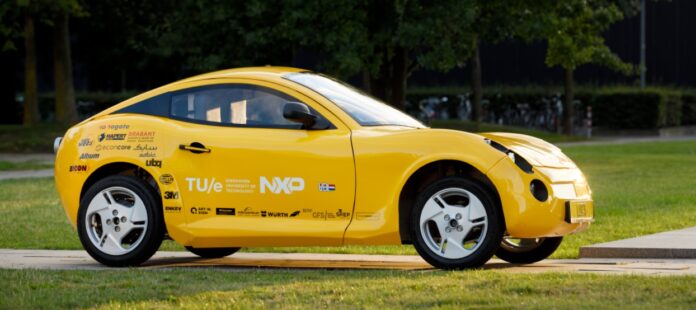To manage the rotation speed of the electric motor, parallel to the frame and no longer transversal, BMW has chosen using the planetary gear reducer.
It is a patent that will be probably integrated on Motorrad Vision DC Roadster, which might revolutionize the sector of electric motor bikes and which concerns the motor, the transmission shaft and the overall agility that this solution would give in terms of design and efficiencies.
The new patent by BMW shows a shaft that is parallel to the frame instead of having a transversal position compared to it. This choice makes the whole motor area more compact and besides it makes use of a shaft with constant velocity joints at each extremity between the motor and the front part of the final transmission of the shaft: the motor can be positioned with more freedom inside the frame.
Moreover, electric motors turn much faster and their rotation, before transmitting the power to the rear wheel of the bike, is managed by a gear reducer directly mounted directly behind the motor, reducing the output shaft speed even keeping it in line with the main motor shaft.
Motor area more compact
The fastest all-electric aircraft by Rolls-Royce
This zero-emissions plane is expected to make a run for the record books with a target speed of 300+ MPH (480+ KMH). The 24ft-wide carbon-fibre aeroplane is being constructed by a 20-man team led by Rolls-Royce at a hangar the Staverton site.
The company hopes the plane will hit a world-beating top speed of more than 300mph when it takes to the skies over the UK in the first half of next year. The current record is 213mph, it was set last year by German-built Extra Aircraft 330LD, powered by a Siemens electric motor.
Inside a bustling hangar bay at the far end of Gloucestershire airport in South West England, a team of British engineers, designers, and data specialists recruited from across Rolls-Royce and beyond have set out to make history. They’re building a high-performance electric aeroplane unlike anything the world has ever seen. Scheduled to take to the skies over Great Britain in 2020, the aircraft will reach a speed of 300 mph – and quite likely more – making it the fastest all-electric plane in history.
This run for the record books is no stunt. It’s part of a Rolls-Royce initiative called ACCEL – short for “Accelerating the Electrification of Flight” – that’s intended to pioneer a third wave of aviation in support of Rolls-Royce’s strategy to champion electrification.
Electric propulsion systems on the water
Hercules Electric Marine, a division of Hercules Electric Mobility, Inc., has recently announced it has reached an agreement with Coach Marine Group (CMG) to supply CMG with electric propulsion systems for use in its Coach and Xcursion branded pontoon boats. The companies have entered the final design and integration phase in which they will partner to tailor the Hercules e-Drive system to CMG’s exact specifications to deliver a superior experience for Coach & Xcursion pontoon customers.
CMG intends to produce up to 1,500 electric pontoons annually featuring an electric inboard/outboard motor that is powered by the Hercules e-Drive system. Financial terms of the agreement are not being disclosed.
Hercules expects to deliver its initial e-Drive systems to CMG in the fourth quarter, enabling CMG to get electric-powered pontoons to its North American dealer network as early as May 2023.
«We’re thrilled to partner with an industry leader like Coach to bring state-of-the-art electrification technology to the marine industry without sacrificing performance», said James Breyer, CEO of Hercules.
The words by Chris Riddle, CMG CEO, are as enthusiastic: «By working together, we’re confident this will be a successful venture for both parties. This is a collaborative effort from design to sales. We’re looking forward to the retail boat show season and other display opportunities this year, showcasing the power, performance and quiet luxury that comes with a Hercules e-Drive mated to a Coach pontoon».
CMG pontoons powered by the Hercules 200-kilowatt e-Drive system will have a top-end speed above 40 mph and approximately 12 hours of cruising time between battery charges. Programmable software enables users to customize power levels for optimal range or to meet waterway horsepower or speed restrictions.
The electric sports car that stems from wastes
Implemented in about 18 months by 22 Dutch students of the Tu/ecomotive team University of Technology, Luca is a prototype of two-seater sports electric car, which boasts a green soul indeed.
The vehicle is equipped with two electric motors, one for each rear wheel, and its weight is just 360 kilograms, with the addition of 60 kg of batteries.
The great peculiarity? Luca has been fully made with wastes, including the plastic fished out of the ocean, recycled Pet bottles for the frame and unsorted household wastes for interiors, which include also two very comfortable customized seats, whose cushions are made with a combination of coir and horsehair.
For the bodywork, they have used recycled Abs, a hard plastic drawn from landfill materials such as TV sets, toys and kitchen appliances.
The two-seater with sports look has a yellow livery made with the application of a film, then easily removed to be recycled again.
Considering wastes as precious material in a car with sports look is then the outstanding frontier exceeded by the team of the project manager Lisa van Etten. «We hope– stated Matthijs van Wijk, member of Tu/ecomotive team – that automotive companies will start using waste materials, already feasible for many applications. We wanted to demonstrate it is also possible to make a frame with them».
Advanced mobility services
ZF has established Car eWallet GmbH, a start-up headquartered in Berlin that will be entrusted by the Germany company with Car eWallet service activities, permitting to pay for the refuelling, for recharging electric cars or also for tolls, parking and car sharing. The project involved then the temporary collaboration between ZF and IBM and UBS partners, positively ending last Spring. Now, the target is further developing and marketing the service: in an initial financial phase, ZF will give the start-up the starting capital; in the future, investors will have to grant funds. «In this way – explained Alexander Graf from ZF Friedrichshafen AG, one of the first creators of Car eWallet and today project manager – we can exploit the dynamism of the scenarios where start-ups operate, where several innovative approaches can be developed more freely and quickly compared to what happens in a corporate structure».
The circular economy Hub of Stellantis was born
Inside Mirafiori district in Turin, Stellantis has established its SUSTAINera Circular Economy Hub (Circular Economy Hub, CE Hub), with an all-round approach based on the strategy of the 4R: Reman, Repair, Reuse and Recycle. Its first activity phase concerns the regeneration of motors, gearboxes and batteries for high-voltage electric vehicles, the reconditioning and the dismantling of vehicles, with the target of adding others in the future.
The Hub, fruit of an investment worth 40 million Euros, provides for the employment of 550 workers by 2025 and will generate over 2 billion Euros of revenues within 2030, in the ambit of the Dare Forward 2030 strategic plan. The primary goal of this forefront Circular Economy Hub is extending the service life of components and vehicles, granting them a longer life. When this is no longer possible, the material is collected for the recycling from the activity of regeneration and dismounting of vehicles at their life end, then reintroduced into the manufacturing cycle to originate new parts and new vehicles.
“The Circular Economy Hub collects competences and activities aimed at creating an excellence centre in Europe,” declared Carlos Tavares, CEO of Stellantis. “We are industrializing the sustainable recovery and the reuse of materials, giving birth to new technologies and competences while we are growing in the sector. Our commitment to the regeneration, repair, reuse and recycle not only will relieve the pressure on our planet, but will also bring financial value to Stellantis, safeguarding our future while we are transforming our manufacturing and consumption model”.
Besides supporting its primary activities, the Circular Economy Hub integrates also the recent actions by Stellantis aimed at strengthening its global electrification ecosystem and at supporting carbon neutrality ambitions, such as the collaboration with Qinomic to develop light commercial vehicles’ electric conversion, and the setup of the first Battery Technology Center in Mirafiori district, to test and to develop in-house batteries for electric vehicles.
Volvo Trucks: 100% electric heavy road transport
Electrifying most of the good transport: Volvo Trucks is precisely ready for this target. According to this vision, at the beginning of 2021, the international player presented three new full-electric models for heavy-duty tasks and a broad variety of transport requirements.
What do they hope? In the EU, almost half of all transports on truck might be electrified in the next future, reducing the climatic impact of road freights.
And it is not utopia. The course is right: with the addition of three new models, the electric range by Volvo Trucks pursues such guideline.
«More and more transport companies –Roger Alm, President of Volvo Trucks, stated- are becoming aware of the immediate need of their electrification course, both to protect the environment and to face competitiveness reasons, to satisfy the requirements of the customers asking for sustainable shipments. The broad diversified offer by Volvo Trucks decisively enables many more transport companies to shift to electric».
Let us go into detail: the new electric Volvo FMX model is subjected to innovation to make transport operations more silent and greener in the yard sector.
The production of the new electric models for Europe will start in the second half of 2022 and will join Volvo FL Electric and Volvo FE Electric for urban transports, which have been mass-produced since 2019 for the same market.
The new products have higher loading capacities, more powerful kinematic chains and maximum autonomy of 300 km, so satisfying the requirements of around 45% of all goods currently transported in Europe, according to what highlighted by Eurostat statistical data.
Milano Digital Week Workshop | Electric mobility, from research to charge column, the feasible course
 Will the electric car be for all indeed? Who is ready for a full electric car today? What do we need in Italy for the electric mobility diffusion?
Will the electric car be for all indeed? Who is ready for a full electric car today? What do we need in Italy for the electric mobility diffusion?
Electric mobility, from research to charge column, the feasible course
Workshop in live streaming, Friday 19th, from 10:00 a.m. to 1.00 p.m. at Milano Digital Week
The Workshop, organized by Electric Motor Engineering and Mecspe, will give concrete answers to these questions involving the whole chain of the present electric mobility world: from applied research to the energy distribution on the territory for the vehicle charge, listening also to the opinions by Bikeconomy international observatory, the indications by ELMO Interuniversity Consortium on the electrification of mobility, the witnesses by some manufacturers of solutions for the automotive industry and by producers of electric vehicles. Today, competences, technologies and infrastructures already enable the sustainable mobility course.
Conference moderator will be prof. Marco Villani, professor of Electric Machines Design and Electric Systems for Mobility at University of L’Aquila and technical director of Electric Motor Engineering review.
| 10.00 – 10.05 | Greetings and start of proceedings | Alessandro Garnero, editorial director Tecniche Nuove Group |
| 10.05 – 10.20 | Event presentation | Marco Villani, professor of Electric Machines Design and Electric Systems for Mobility at University of L’Aquila. |
| 10.20 – 10.40 | RESEARCH – Synergies at the service of research and sustainable development in the e-mobility sector | Ciro Attaianese, University of Naples Federico II and President of Elmo Consortium |
| 10.40 – 11.00 | ECONOMY & MOBILITY – Sustainable multi-mobility astride Next Generation EU and urban and territorial regeneration | Gianluca Santilli, President of Bikeconomy Observatory |
| 11.00 – 11.20 | AUTOMOTIVE, The electric car for all | Stefano Sordelli, Future Mobility Manager of Volkswagen Group Italia |
| 11.20 – 11.40 | AUTOMOTIVE, The electric mobility of the future: Bosch vision | Federico Brivio, Director, customer Electrification, Robert Bosch S.p.A. |
| 11.40 – 12.00 | TECNICA, European Project H2020 Refreedrive: new solutions of electric motors for automotive | Giuseppe Fabri, researcher at the Department of Industrial Engineering and Information and Economics of University of L’Aquila |
| 12.00 – 12.20 | TECHNOLOGY, Schaeffler innovative systems and components for sustainable mobility solutions | Eugenio Bizzocchi, Director Automotive Technologies Schaeffler Italia |
| 12.20 – 12.40 | INFRASTRUCTURES, Direct Current Infrastructures for electric vehicle charge – Protection and Sectioning | Marco Carminati, Global Direct Current & Arc Flash Mitigation Applications Specialist, ABB Group |
| 12.40 – 13.00 | UTILITY | ENEL |
Stellantis stakes on Italy, next step the gigafactory in Termoli
On the occasion of the recent EV 2021 Day event, Stellantis has announced that in Termoli (Molise, Italy), it will be built the third gigafactory in Europe, after those in France and in Germany. It is at stake the conversion of FCA production plant in Molise, established in 1972 and specialized in the production of motors and transmissions. The mission of the factory, which employs 2500 workers and takes up an area of 1.2 million square metres, will be producing batteries.
The young Group’s investment will amount to over 30 billion Euros by 2025 in electrification and software. «The target of Stellantis – stated the CEO Carlos Tavares – is that electrified vehicles succeed in representing over 70% of sales in Europe and more than 40% of those in the United States within 2030. Besides, in the future of Stellantis there are four platforms for electric ones and also sound-state batteries. The requirements of batteries and components for EV by Stellantis will be satisfied by five gigafactories in all and the plant in Termoli represents a consistent choice in the context of the course of Stellantis, which is supporting the energy transition of all of its Italian industrial sites, with the aim of assuring their sustainability through the improvement of their performances and to make the Country play a strategic role among the primary domestic markets of the Group.
India, sale of electric vehicles without batteries
Batteries comprise 30-40% of the upfront cost. To push electric mobility, the Ministry of Road Transport and Highway (MORTH) of India, announced that all the states and union territories (UTs) have now been allowed the registration and sale of electric vehicles (EVs) without pre-fitted batteries.
The move is likely to provide the necessary boost for the wider adoption of EVs across the country.
Practically, the government is striving to create an ecosystem to accelerate the uptake of electric mobility in the country. This will not only protect the environment and reduce the oil imports but also provide opportunities to the sunrise industry.
What is the situation in India? According to the Society of Manufacturers of Electric Vehicles, the sale of electric vehicles in this country increased by 20% in 2019-20, mainly driven by rising sales of two-wheelers.













